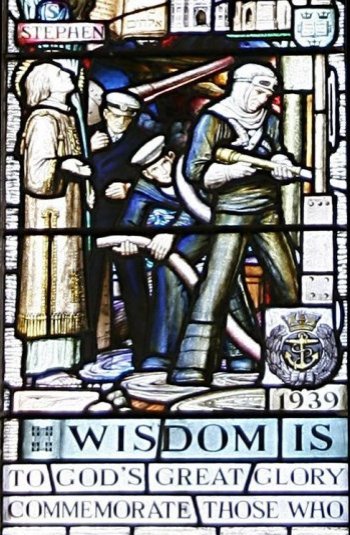
The bottom row of three panels depicts members of the armed services. In this scene at the bottom of the left light we see the Navy at work. A rating in protective clothing is directing a jet of water, presumably at a fire, while the seaman behind him holds the hose. The officer in the rear oversees the operation. In the tradition of the unknown soldier, these are generic figures rather than portraits of identifiable individuals. A large naval gun can be seen in the background, while a naval badge is depicted in the foreground, over the date 1939. This date is paired with 1945 in the bottom left of the corresponding panel in the right light to denote the period of the Second World War. We also see the leftmost portions of the captions across the bottom of the window, which are discussed elsewhere in the context of the window as a whole.
To the left of the picture stands the figure of St Stephen. Stephen is first mentioned in Acts chapter 6 as "a man full of faith and of the Holy Spirit", and he was one of seven deacons appointed by the disciples to oversee the distribution of food in the community. "Stephen was filled with grace and power and began to work miracles and great signs among the people." (Acts 6:8) Opposition arose however, and he was taken before the Sanhedrin where many false accusations were made against him. In answer, Stephen gave a long account of God's goodness to the people of Israel throughout their history, and of their poor record of keeping the law. "They were infuriated when they heard this, and ground their teeth at him." (7:54). Stephen is depicted in this window looking up with hands open, palms upward: "Stephen, looking up steadfastly to heaven, saw the glory of God, and Jesus standing on the right hand of God, and said 'Behold, I see the heavens opened, and the Son of man standing on the right hand of God'" (7:55). This defiant statement was sufficient to have Stephen condemned, and he was stoned to death, becoming the first recorded Christian martyr.